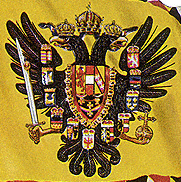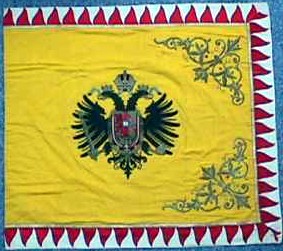
This page is part of © FOTW Flags Of The World website
Austro-Hungarian Empire: Military Flags
Last modified: 2023-10-28 by martin karner
Keywords: military colours | regimental colours | austro-hungarian empire | eagle: double-headed (black) |
Links: FOTW homepage |
search |
disclaimer and copyright |
write us |
mirrors
See also:
![[Cavalry standard 1816]](../images/a/ah^cav1769.jpg) image located by William Garrison
image located by William Garrison
"The Flag Heritage Foundation and the Military History Museum in Vienna, Austria are pleased to
announce that the donation by the Foundation to the Museum of an original Austrian cavalry standard 1769
patterned from the time of Maria Theresia (1740–1780) has been completed successfully"
(from the Flag Heritage Foundation's website,
12 June 2013).
located by William Garrison, 6 September 2023
The shield displays the arms of Empress Maria Theresia, as she was the
Queen of Bohemia and Hungary in her own right and Empress Consort of
the Holy Roman Empire. Regarding the dexter half, not only the fields
are arranged in an unusual way, but the stripes of Hungary Ancient are
reversed as well – there was a volatility regarding their arrangement
since the introduction of the arms until the mid-19th century (1848, I
think), when the present-day arrangement was fixed.
Tomislav Todorovic, 6 September 2023
![[Austria-Hungary: Infantry flag Model 1816]](../images/a/ah-aust.gif) image by Istvan Molnar, 15 July 2001
image by Istvan Molnar, 15 July 2001
Source: www.heraldica.org
According to Mell (Die Fahnen des österreichischen Soldalen im Wandel der Zeiten, Vienna, Bergland Verlag 1962, ill.52,
opposite p.48) this is an Infantry flag Model 1816, possibly that of the 6 Grenz Infanterie Regiment preserved in the Military Historical Museum in
Vienna.
Turning to my uniform file, I found two additional illustrations of the M1816
Infanteriefahne. One (in black and white) on p. 23 of Pavlovic, The Austrian Army
1836–66 (I) Infantry, Men-at-Arms series 323, Oxford: Osprey Publishing, 1999; the other (in color) as plate 53 in Lucas, Fighting Troops of the
Austro-Hungarian Army, Tunbridge Wells (Kent): Spellmount Ltd, 1987. In the latter it is not identified by date. In short we can identify the flag as an
early to mid- 19th century Infantry Color (probably 1816).
Norman Martin, 15 July 2001
This is certainly an Austrian infantry colour. Though very similar to the
imperial standard, the standard was square not rectangular, had a border also on the hoist side, and was not (normally)
nailed to a mast but hoisted from a halyard. Particularly the image shows the traditional Austrian system of attaching infantry colours to their
masts, with a specific number of nails at given distances along and given angles around the mast, this in turn being painted in the same imperial
colours as the triangles on the border (Zackenrand) of the colour.
A very similar flag is shown on Brian L. Davis
(1975), "Flags and Standards of the Third Reich 1933–1945", pp. 94 and 115–117, that of the "Hoch- und
Deutschmeister Regiment Nr.4", a German regiment (after the 1938 Anschluss) which was invested with the heritage of the Austrian regiment of the same
name. Except for the colours of the Zackenrand (which were altered to the German red-white-black instead of the Austrian imperial
red-white-black-yellow) the flag was identical to an Austrian colour following the 1868 regulations. The order of the escutcheons is here, from
dexter to sinister wing tips:

image by Santiago Dotor, 18 July 2001 |
- Hungary
- Lombardo-Veneto kingdom (the snake azure of Milan and the lion of
St. Mark of Venice)
- Illyria (sic, possibly Istria? -- it looks like the 3rd escutcheon on
the link reported by István)
- Siebenergen (Transylvania)
- Moravia impaling Silesia
- Tyrol
- Austria above the Enns impaling Austria below the Enns
- Salzburg
- Styria
- Esclavonia (sic, actually Galicia and Lodomeria)
- Bohemia
|
Santiago Dotor, 18 July 2001
 image located by William
Garrison
image located by William
Garrison
Image posted on eBay, with the description by the poster:
"Imperial Austro-Hungarian Hapsburg Standard Flag
This is an Original
Imperial Austro-Hungarian Standard / Banner made before 1918. The banner
measures approx. 56"X 56" and is in excellent condition with only moderate
wear from handling and storage. The center silver plaque, 1"X 1" from the
obverse side was missing when I obtained this flag 30 years ago and I have
placed 19th century material (silver wire) over the area. The obverse side
of the banner is the Royal Hapsburg Eagle. The reverse motif I believe
represents a city within the Austro-Hungarian Empire. The colored portions
of the flag are heavy silk material. All of the decoration that looks like
wire or metal is silver or gilt material. Everything on this flag is hand
sewn, there is nothing printed at all."
located by William Garrison, 11 May 2009
This flag is rather mysterious. All in all, the state of the flag is too
good, too excellent for a flag of this age. Either it has been made after
1918 (then probably before 1938, though) or it has not been used much.
The arms on the reverse is another mystery: I have checked my sources
and I haven't found any similar municipal arms. Not only the parts of the
arms, but also the whole layout is somewhat strange, as the ivy (?) branches
fill the biggest part of the arms, although perhaps being derived from a
merely decorative arabesque pattern.
The usage of the flag is totally
unclear. It certainly was not a military standard of a regular unit, as
these were quite strictly regulated. So, it was either a standard of a
militia ("Bürgermilitär" or the like) unit or perhaps a mayor's standard.
For all these uses, one would expect some inscription of the
military/paramilitary unit's designation etc. Another idea, that would also
explain the good state, is that it was a flag never actually finished and
therefore never used. This would explain the lack of inscriptions and that
only two of the corners show the decorative pattern.
M. Schmöger, 1 June 2009
 image by Željko Heimer
image by Željko Heimer
It seems that very long flags were used in early 20s in the Hungarian
part of the Empire, judging from some flags preserved in the Croatian
History Museum of the period, cf. Croatian tricolour mass-produced around
1894, measuring 173x369 cm, HPM/PMH 11703, Borošak-Marijanović catalogue
1996, p. 110;
http://zeljko-heimer-fame.from.hr/descr/hr-hist.html#hr-189x ; and an
Austro-Hungarian military flag measuring 168x565 cm, same source, same page.
Flag 27 from page 110 is captioned in the book "Flag of Austria-Hungary"
(which is basically correct although not quite precise). The flag is
produced, according to the catalogue in 1916 (this is the date of
introduction of this form of the coat of arms, so the actual production may
have been 1916–1918) by printing on wool cloth (printing may suggest that
this was kind of a standard issue in the Austrohungarian military, possibly
printed in Vienna and issued to various military units and institutions.
The size of the flag in the Croatian History Museum (where the flag is
preserved under item nr. HPM/PMH 32447) is given as 168x565 cm (according to my
calculations, the original flag would have been 168x595 to match the
construction details, but the cloth apparently shrunk since [or one may also
imagine a typo in the catalogue 565 for 595]). The flag is white with a border
made of triangles in the Austrohungarian colours following this order:
black-yellow-red-white-green, with the corner pieces being black and having 39
outwards pointing triangles along the length and 9 along the width. In the
middle of the flag is the lesser coat of arms of Austria-Hungary, introduced in
1916 adding the Croatian field to the Hungarian part of the coat of arms. The
drawing of the coat of arms used on the flag follows closely the drawing by
Ströhl, see e.g.
http://commons.wikimedia.org/wiki/File:Wappen_%C3%96sterreich-Ungarn_1916_(Klein).png
although Ströhl's drawing in the book indicates shading and similar artistic
effects, which are missing from the drawing in the flag, where simple colours
and considerably less shading is used (as required by the printing process, no
doubt). However, the similarity of the drawing makes me think that the flag
might have been produced in Vienna under the same authorities.
According
to Jelena Borošak Marijanović, the actually flag from the Museum was used flying
over the Military Hospital in Zagreb (at the time in Vlaška Street 87, see
photo, although without any flag at
http://www.kbd.hr/interkardio/Staro/slike-povijest/Zgrada%20u%20Vlaskoj.jpg).
There does not seem to be any apparent hoisting method noticeable on the
flag, so we may only speculate how it was being displayed. It seems to me that
such a flag would be too long for horizontal hoisting (and the building does not
have any suitable flag pole), and the coat of arms seems to indicate that
vertical hoisting was not intended (that does not mean that it was not done). It
may also have been attached as a very long flag from a slanted flagpole on the
facade or some other way, or it was simply hung out from window(s) vertically or
horizontally – we may never know ... although the archives in Zagreb may have
somewhere a photo of this flag actually being used, one would probably have to
dig it up painfully :)
Now for the question of what this flag would be.
It is certainly not the "national flag" of the Monarchy, as there was never
anything like that is the modern sense of the term, but it may be that it was
kind of a war flag, as termed in the FIS dot system (our indication of the
system we would used
 ) although I
am far from sure that such was ever officially prescribed - if it was really
mass produced and
used on military installations it surely classifies as such.
) although I
am far from sure that such was ever officially prescribed - if it was really
mass produced and
used on military installations it surely classifies as such.
Željko Heimer, 3 January 2008
Does anybody recognizes this flag:
http://img13.imageshack.us/img13/6463/18vz7.jpg? A similar flag seems to be
in this one:
http://img15.imageshack.us/img15/5867/61hn7.jpg. (Images from a photostream
at
http://www.militaryphotos.net/forums/showthread.php?151191-Old-pictures-Nazi-Deutschland-WWII
Alex Danes, 12 March 2009
It seems to be some kind of Austrian-Hungarian military flag (banner). If I
am not mistaken, certain Nazi German units used flags "in tradition" with
Austria-Hungary and this may be one such example, so presumably the photo may
have been taken somewhere in Austria after the Anschluss. A similar (but not
entirely the same) flag is shown in the Davis/McGregor "Flags of the Third Reich
1: Wermacht" of the Osprey Man-At-Arms Series book 270; on Table E under nr. 4
captioned: 'Hoch- und Deutschmeister' flag, IR 134.
Željko Heimer, 12 March 2009
These are basically, as Željko wrote, some traditional Austro-Hungarian
regimental colours. However, my father (who has quite some knowledge about
uniforms) pointed me to a few details of the uniforms:
– most of the
soldiers have stand-up collars with rank insignia, a feature of the Austrian
army 1933–38
– on the other hand, they already wear the German Wehrmacht
eagle on the breast, as well as (at least visible on the second photo) the
black-white-red shield on the helmet.
So, these photos have probably been
taken quite shortly after the Anschluss in 1938. Flag usage in the newly
absorbed, formerly Austrian, units is difficult to ascertain.
M. Schmöger, 15 March 2009


![[Cavalry standard 1816]](../images/a/ah^cav1769.jpg) image located by William Garrison
image located by William Garrison
![[Austria-Hungary: Infantry flag Model 1816]](../images/a/ah-aust.gif) image by Istvan Molnar, 15 July 2001
image by Istvan Molnar, 15 July 2001
 image by Željko Heimer
image by Željko Heimer